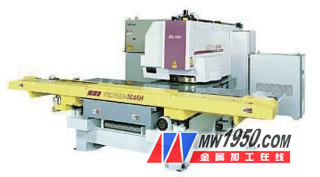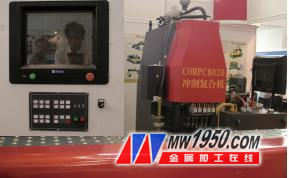CNC laser (plasma) high-speed die-cutting composite processing has a wide range of needs in the sheet metal processing industry. It can combine the usual blanking process of sheet metal, or replace the traditional angular die blanking material that causes edge deformation and severe mold loss with high quality cutting, no edge deformation and no mold loss laser (plasma) ) Cutting, which greatly improves production efficiency and product quality, and reduces costs, as shown in Figure 1. The control of CNC laser (plasma) high-speed die-cutting combined processing is not simply to combine the functions of the punching machine and the cutting machine, and to perform the punching processing in sequence. Key technologies include organically optimized combination and synergy of punching movements and processes, and die-cutting mechanical clamping and support mechanisms. The cutting head design of the die-cutting compounding machine usually has two forms: fixed or mobile, and the two designs have their own advantages. The fixed design completely utilizes the movement of the plate to realize the processing, the mechanical structure is simple, and the worktable is not required to be exchanged; the control is relatively convenient, and the workpiece is not required to be repositioned. But for large or medium plates, this form is sometimes not practical. The design of the mobile cutting head makes up for this deficiency. For the large door cutting, the moving cutting head is a more reliable and effective solution, but it will add some complexity in the structure and control of the repositioning of the board and the interaction of the table. . This article introduces the control characteristics of the CNC die-cutting composite machining center: (1) Set die die control, punch control and cutting process control, cutting height control in one, automatic switching. In a typical die-cutting composite machining process, the clamp moving sheet is first punched. After processing, the clamp moves the sheet to the cutting torch for cutting. In the punching phase, the CNC is required to automatically/manually position the positioning block, automatically/manually select the die in the magazine, manually adjust the punch position, control the speed/impact, and detect the upper and lower dead points. In the cutting stage, the numerical control is required to confirm the relative position of the cutting edge and the punching hole, automatically track the cutting height, and control the cutting speed, tool compensation, height, power and other process parameters according to the characteristics of the sheet. The CNC must be able to automatically detect the current punching or cutting phase, complete the motion control, process control and error proof control, and perform the switching transition control between punching and cutting. (2) A key technology of the die-cutting machine is the transition control of the die cutting. This includes exchange workbench, workpiece repositioning, CNC punching process control switching and error proof control during transition. In a die-cutting machine designed with a moving cutting head, the punched sheet must be moved from the punch table to the cutting table. The CNC is controlled according to different exchange workbench designs. When the sheet is moved to the cutting table, the CNC must calculate the cutting starting point according to the position at which the workpiece is released onto the cutting table, and move the cutting head for positioning. For more precise positioning requirements, when the pre-programmed positioning cannot meet the requirements, the CNC even needs to detect the calibrated reference hole or positioning block and scan the flatness of the plate placement. Two kinds of punching and laminating machines are shown in Figure 2 and Figure 3. Figure 3 Punching machine using the TNC2000D CNC system The main performance indexes of typical composite machines suitable for medium and heavy plate die-cutting composite processing are shown in Table 1. The key performance indicators of a typical CNC for a die-cutting compounding machine are shown in Table 2.
Brass fasteners are used for their physical and aesthetic properties. Brass is utilized due to its high thermal conductivity and corrosion resistant properties, it is suitable for use in hot and cold environments, and resistant to water corrosion, making it a staple of industries such as heating and plumbing. Brass fasteners are largely non-magnetic (like any fastener, slight magnetic properties can develop during the manufacturing process) and resistant to tarnishing.
Metal Pins,Stainless Steel Pins,Flange Alignment Pin,Safety Coupler Pin Taizhou Hongchuang Hardware Co., Ltd. , https://www.taizhouhongchuang.com
Figure 1 Parts of the die-cutting machine 
Figure 2 Die-cutting compound machine from foreign manufacturers (MURATEC) 


Note: The stationary cutting table is used for the static cutting table or the special punch table with the workpiece repositioning function. 
Brass fasteners are suited for some marine environments, including brackish water and slow current sea water; brass in this environment develops a protective green coating. Brass fasteners are also commonly used with wood applications, as the golden coloring blends well with the tan wood. Brass is a softer metal and must be used with care, always drilling pilot holes and using driver bits that fit the head of the screw precisely to prevent stripping. Brass Bolts also require a pilot hole be driven before installtion.